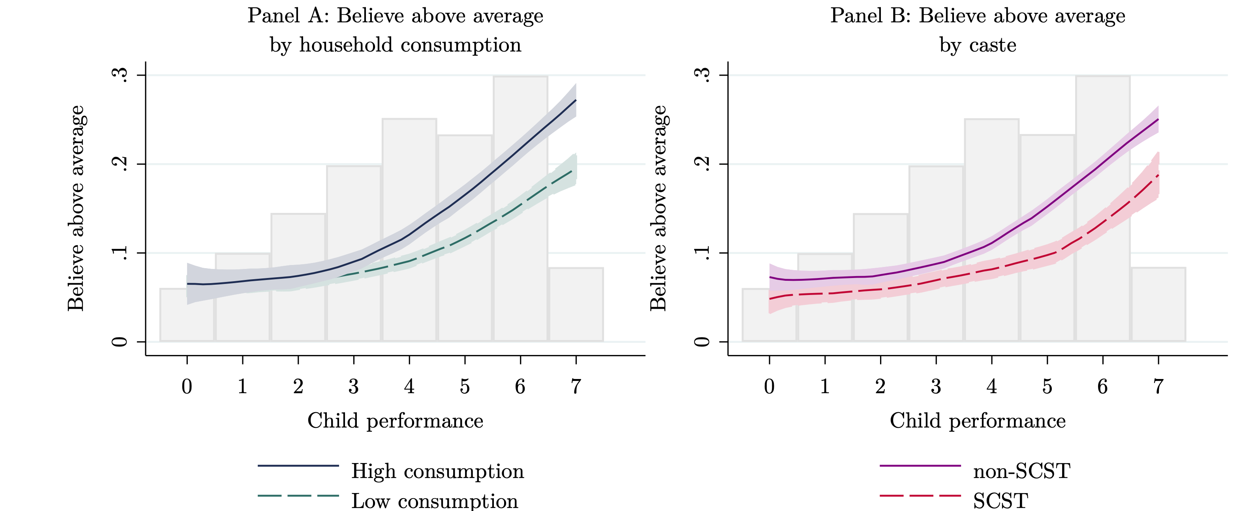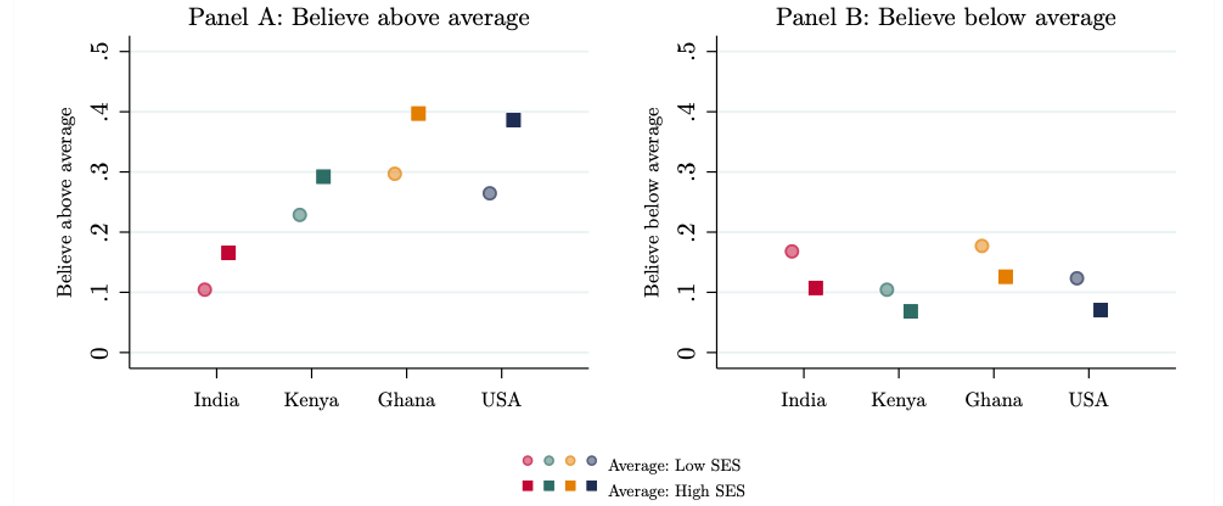This article highlights the prevalence of socioeconomic disparities in parental beliefs about their child’s performance – often outpacing actual disparities in academic performance. Analysis using data from India, the USA, Kenya, and Ghana shows that parents with lower socioeconomic status – as measured by household consumption and caste identity – are more likely to think that their child is below average. It explores the factors that could drive these beliefs and quantifies the impact of below-average parental beliefs on educational investment in children.
Parents’ beliefs about their child’s academic achievement may play an influential role in the child’s life outcomes. Such beliefs may determine the type of investments parents make in their child’s education (Dizon-Ross 2019), and could influence the child’s self-confidence, motivation, and effort.
Existing research reveals socioeconomic disparities in beliefs about how educational investments translate into outcomes, the importance of early investments, the returns to education, and available educational opportunities across a variety of contexts (Cunha et al. 2013, 2022, List et al. 2021, Guyon and Huillery 2021, Jensen 2010). However, there has been little research which explores potential disparities in parental beliefs about child academic achievement – beliefs which are themselves fundamental inputs to educational investment decisions – along socioeconomic lines.
The study
In a recent study (Duhon 2023), I document disparities in parental beliefs by socioeconomic status (SES) across four diverse contexts, and then explore factors that could potentially contribute to these disparities. While this article focuses on findings from the Indian context, the broader study also generates insights from the USA, Kenya, and Ghana using comparable data.
This study uses data from the India Human Development Survey (IHDS), a nationally representative dataset that includes over 22,000 children aged 8 to 11 from 40,000 households surveyed across two waves (2004-05 and 2011-12). The IHDS contains three components core to the analysis: First, parents were asked whether they believe their child to be an above average, average, or a below average student. Second, each child was assessed for basic competency in math and reading using an adaptation of the widely used ASER assessment, which provides an objective measure of the child’s performance. Third, the survey collected detailed measures of household SES, including per capita consumption, whether the household belongs to Scheduled Castes or Scheduled Tribes (SC/ST), parental education, and poverty status.
These three components – stated parental beliefs, child assessment scores, and measures of SES – facilitate exploring whether there are systematic socioeconomic differences in how parental beliefs about child academic achievement compare to actual measures of child performance.
Disparities in parental beliefs by SES
A core finding of the study documents substantial disparities in parental beliefs by SES. Children from more socioeconomically advantaged backgrounds outperform their less advantaged peers, likely due to disparities in resources and other inputs throughout childhood. However, disparities in beliefs about academic achievement along socioeconomic lines substantially outpace any actual disparities in academic performance.
Figure 1 illustrates these patterns, depicting the likelihood that parents believe their child is above average across different levels of actual child performance, separately for two potentially meaningful dimensions of SES: household consumption and caste. Even accounting for actual performance, parents from high consumption households are substantially more likely to believe their child is above average compared to those from low consumption households (Panel A). Similarly, parents from India’s historically disadvantaged castes are less likely to believe their child is above average compared to non-SC/ST parents (Panel B). The reverse patterns also hold: Accounting for performance, below-average beliefs are less common among high-SES parents, and more common among low-SES parents.
Figure 1. Likelihood of belief that child is above average, by household consumption and caste

Notes: (i) Histograms (grey bars) show the distribution of child performance combining across math and reading scores on a scale ranging from 0 to 7 (x-axis). Children scoring 0 cannot recognise numbers or letters. Children scoring 7 can solve division problems and can read a story. (ii) Overlaid on child performance are local linear regressions (colored lines) of above-average beliefs by household consumption (Panel A) or caste (Panel B) separately. Here, child performance is captured using scores standardised relative to other children of the same age. (iii) ‘Believe above average’ (y-axis) is a binary measure (0 or 1), and values can be interpreted as the likelihood that parents believe their child is above average.
These patterns persist in a regression framework with additional controls (including for example, child performance, age, gender, and village fixed effects). Specifically, a doubling of household consumption is associated with a 5 percentage point increase (equivalent to a 26% increase) in the likelihood that a parent believes their child is above average, and a 4 percentage point (17%) reduction in the likelihood that a parent believes their child is below average. Similarly, above-average beliefs are 1.5 percentage points (11%) less likely, and below-average beliefs are 2.2 percentage points (15%) more likely among SC/ST compared to non-SC/ST parents in a regression model which additionally controls for other relevant dimensions of SES (household consumption and parent education).
Similar patterns emerge in other contexts, as seen in Figure 2 which plots average beliefs across India, the USA, Kenya, and Ghana, separately for high-SES and low-SES parents (defined using consumption/income in India and the USA, and educational attainment in Kenya and Ghana). The key takeaway is that across these four contexts, above-average beliefs are consistently more likely among high-SES parents, while below-average beliefs are consistently more likely among low-SES parents. Similar patterns emerge when accounting for performance by comparing average beliefs across high-SES and low-SES parents separately for children with below average, average, or above average performance.
Figure 2. Average likelihood that parents believe their child is above or below average, by SES across four countries

Importantly, parental beliefs correlate with actual educational investments, even after accounting for relevant household characteristics. Parents with above-average beliefs allocate 3 percentage points (21% relative to the mean) more of their budget to education, and their children spend over 70 additional minutes each week on educational activities compared to those with average beliefs. In contrast, children of parents with below-average beliefs miss nearly a whole extra school day each month (27%), and are 19 percentage points (30%) less likely to continue to secondary school.
Similar patterns emerge in other contexts, pointing to a robust link between parental beliefs and educational investments. While this analysis is largely correlational, and factors not accounted for could influence both beliefs and educational investments, the findings are consistent with existing research demonstrating a clear, causal relationship between beliefs and investments (Dizon-Ross 2019, List et al. 2021).
How SES shapes parental beliefs
Further, evidence from both India and Kenya suggests that these patterns reflect not only a correlational relationship, but that SES to some extent causally shapes parental beliefs about child academic achievement. In Kenya, existing research shows that parental exposure to a randomised early-life health intervention (childhood deworming) led to improvements in education, health, economic circumstances, and labor market outcomes in adulthood, as well as lower child mortality in the next generation (Miguel and Kremer 2004, Baird et al. 2016, Hamory et al. 2021, Walker et al. 2023).
Adopting a similar analytical approach and using the same sample, my study finds an increase in above-average beliefs and a decrease in below-average beliefs among parents who received additional years of childhood deworming. These results suggest that some combination of the later-life educational, health, and economic benefits associated with the deworming intervention – factors that characterise or reflect one’s SES – may causally shape beliefs about academic achievement among the next generation.
The study also finds that beliefs among parents in rural India respond negatively to shocks driven by adverse rainfall. In response to unusually low rainfall, agricultural income declines, and above-average beliefs become 5 percentage points less likely, while below-average beliefs become 8 percentage points more likely. Together, these findings provide support for the hypothesis that financial circumstances (India) and socioeconomic status more generally (Kenya) may causally shape beliefs.
What factors could explain the observed relationship between SES and parental beliefs? First, parents may lack complete information about their child’s academic performance, and in its absence, make inferences based on assumptions about how children from a similar background tend to perform. These assumptions could be influenced by exposure to role models, by positive or negative stereotypes, or by perceptions of the external constraints and opportunities associated with one’s SES. These assumptions could influence how parents perceive their own child’s academic achievement and potential, leading to the observed patterns.
Indeed, survey evidence from Kenya collected to explore some of these hypotheses shows that such perceptions may loom larger for low-SES parents, for whom external constraints may seem more limiting, and opportunities fewer (Duhon 2023). To explore these hypotheses in the Indian context, I partnered with Saajha and conducted a Whatsapp-based survey experiment with a sample of over 900 parents in Delhi. We find that parents primed to have resource constraints at the top of their mind reported lower confidence in having the resources to support their child, while those sent an encouraging message that even small amounts of time can make a positive difference in their child’s development are less likely to report their child is below average academically, or will be in the future.1
Psychological factors associated with SES could also shape parental beliefs. The same factors associated with poverty or socioeconomic disadvantage that may pre-dispose individuals to depression, hopelessness, and lower self-efficacy (Ridley et al. 2020, Duflo 2012, Lybbert and Wydick 2022, Wuepper and Lybbert 2017) could similarly influence parental beliefs. Indeed, in other contexts included in this study, above-average beliefs are more common and below-average beliefs less common among parents who are less depressed, more hopeful, and exhibit higher self-efficacy. Further, parents in the Kenyan sample exhibit improved psychological well-being (Duhon et al., 2023), which could be one of several channels driving the improvements in parental beliefs observed in the present study.
Conclusion
This research finds evidence of disparities in parental beliefs by SES in India and other country contexts. Above-average beliefs are more common among high-SES parents, and below-average beliefs among low-SES parents, even when accounting for actual child performance. To the extent that parental beliefs influence educational investment decisions, disparities in parental beliefs by SES could also contribute to the persistence of educational inequalities across generations. Awareness of these disparities could help influence the design of policies and programmes that may help disadvantaged parents better support their child's learning and development.
Further, exploring factors that drive these disparities could be a promising avenue for research, particularly if the same factors influence other areas of economic decision making. For instance, deciding whether to migrate for work may depend on beliefs about one’s employment opportunities and wages, and deciding whether to invest in a new agricultural technology may rely on beliefs about one’s expected productivity. If some feature of socioeconomic disadvantage causes individuals to systematically underestimate these kinds of outcomes, this could adversely impact economic decision making.
Note:
- Sincere thanks to the Saajha team for facilitating this research.
Further Reading
- Baird, S, J H Hicks, M Kremer, and E Miguel (2016), “Worms at work: Long-run impacts of a child health investment”, The quarterly journal of economics 131(4), 1637–1680.
- Cunha, F, I Elo and J Culhane (2022), “Maternal subjective expectations about the technology of skill formation predict investments in children one year later”, Journal of Econometrics 231(1), 3–32.
- Cunha, F, I Elo and J Culhane (2013), “Eliciting maternal expectations about the technology of cognitive skill formation”, National Bureau of Economic Working Paper No. 19144.
- Desai, S and R Vanneman (2018), “India human development survey (IHDS) 1 (2005) and 2 (2012).” The University of Maryland and the National Council of Applied Economic Research, New Delhi
- Dizon-Ross, R (2019), “Parents’ beliefs about their children’s academic ability: Implications for educational investments”, American Economic Review 109(8), 2728–65.
- Duflo, E (2012), “Hope as capability”, in: Tanner lectures on human values. Harvard University, Cambridge, USA.
- Duhon, M (2023), “Socioeconomic status shapes parental beliefs about child academic achievement: Novel evidence from India, Kenya, Ghana, and the USA”, Working paper.
- Duhon, M, L Fernald, J Hamory, P Kariger, E Miguel, E Ochieng and M Walker (2023), “Complementarities in Human Capital Production: Causal Evidence on Intergenerational Impacts in Kenya”, Working paper.
- Guyon, N and E Huillery (2021), “Biased aspirations and social inequality at school: Evidence from French teenagers”, The Economic Journal 131(634), 745–796.
- Hamory, J, E Miguel, M Walker, M Kremer and S Baird (2021), “Twenty-year economic impacts of deworming”, Proceedings of the National Academy of Sciences, 118(14).
- Jensen, R (2010), “The (perceived) returns to education and the demand for schooling”, The Quarterly Journal of Economics 125(2), 515–548.
- List, J A, J Pernaudet and D L Suskind (2021), “Shifting parental beliefs about child development to foster parental investments and improve school readiness outcomes”, Nature communications 12(1), 5765.
- Lybbert, T J and B Wydick (2022), “Hope and poverty in development economics: Emerging insights and frontiers”, CEGA Working Paper Series No. WPS-211.
- Miguel, E and M Kremer (2004), “Worms: identifying impacts on education and health in the presence of treatment externalities”, Econometrica 72(1), 159–217.
- Ridley, M, G Rao, F Schilbach and V Patel (2020), “Poverty, depression, and anxiety: Causal evidence and mechanisms”, Science 370 (6522).
- Walker, M W et al. (2023), “Intergenerational child mortality impacts of deworming: Experimental evidence from two decades of the Kenya Life Panel Survey”, National Bureau of Economic Working Paper No. 31162.
- Wuepper, D and T J Lybbert (2017), “Perceived self-efficacy, poverty, and economic development”, Annual Review of Resource Economics 9, 383–404.




 21 November, 2023
21 November, 2023 




Comments will be held for moderation. Your contact information will not be made public.